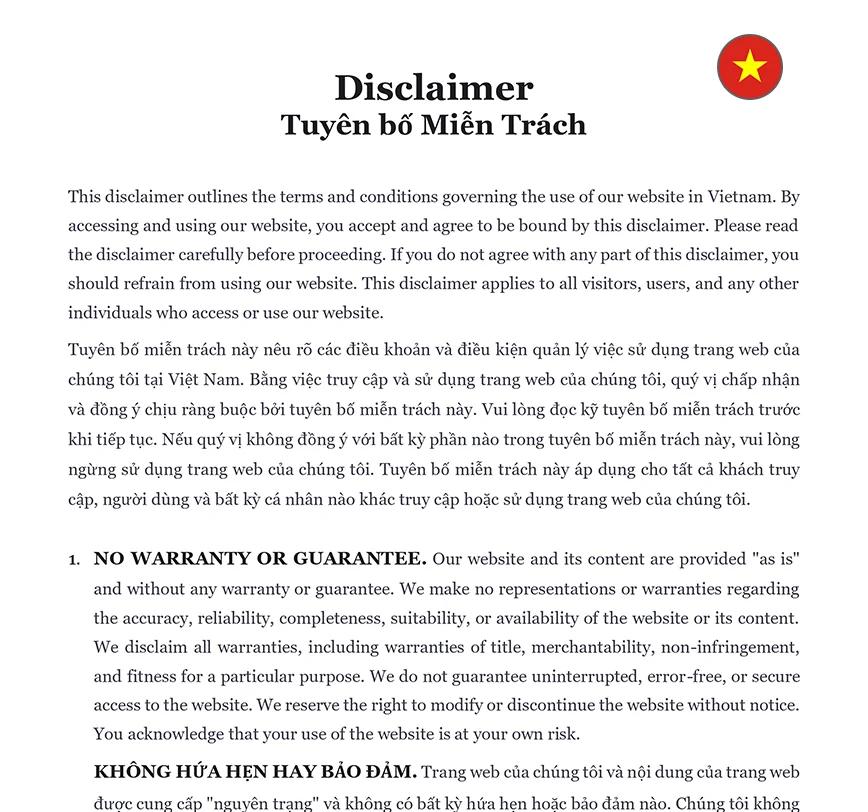Ready to use legal template
Drafted by experienced lawyers
Vietnamese-English translation
Ready to use legal template
Drafted by lawyers
Vietnamese-English translation
Home › Intellectual property › Disclaimer
Learn more about Website Disclaimer in Vietnam
A Disclaimer stands as a crucial tool in the realm of law, serving to delineate and mitigate potential liabilities by outlining the boundaries of legal responsibility. Whether you’re a business owner, a content creator, or an individual seeking to protect your rights, our comprehensive range of Disclaimers is tailored to meet your specific needs. Developed by our team of seasoned legal experts, each Disclaimer is meticulously drafted in strict accordance with the intricate legal landscape of Vietnam. Presented in an easily editable Word format, our Disclaimers empower you with the flexibility to customize and implement them seamlessly into your operations. With Themis Partner, rest assured that you’re equipped with legally sound protections that align perfectly with Vietnamese regulations. Explore our collection today and take control of your legal compliance effortlessly.
Table of contents
-
What is a Disclaimer?
-
What is included in a Disclaimer?
-
Why are Disclaimers important in Vietnam?
-
Are there different types of Disclaimers?
-
Does it remove liability for negligence or harm?
-
How does it interact with Terms and Conditions?
-
How does it address potential legal disputes?
-
What risks can arise if I don't have a Disclaimer in place?
What is a Disclaimer?
A Disclaimer is a legal instrument utilized to delineate and define the boundaries of responsibility or liability in various contexts. Whether found on websites, products, services, or documents, its primary function is to inform users, consumers, or parties involved about the inherent risks, limitations, or conditions associated with a particular activity or information provided. By explicitly stating what is not guaranteed, warranted, or assumed, a Disclaimer seeks to manage expectations, reduce misunderstandings, and shield parties from legal consequences arising from certain actions, decisions, or outcomes.
This legal notice can vary significantly in scope and content depending on the context and jurisdiction, covering aspects such as warranties, accuracy of information, risks involved, and the extent of liability limitation. Often drafted with meticulous attention to detail by legal professionals, Disclaimers aim to provide clarity, transparency, and protection for all parties involved, helping to establish a framework for interactions and transactions while minimizing potential legal disputes or claims.
What is included in a Disclaimer?
A Disclaimer typically includes several key components to effectively communicate its message and provide legal protection. These components may vary depending on the specific context and purpose of the Disclaimer, but commonly include:
Identification of Parties: The Disclaimer may begin by clearly identifying the parties involved, such as the company, website, or individual providing the disclaimer, and the users, consumers, or recipients who are subject to its terms.
Statement of Intent: It often contains a statement indicating the purpose or intention of the Disclaimer, such as clarifying the scope of information provided, outlining limitations, or disclaiming liability for certain actions or outcomes.
Limitation of Liability: This section outlines the extent to which the party issuing the disclaimer accepts or disclaims responsibility or liability for various matters, including but not limited to accuracy of information, product performance, or potential risks associated with the use of services or products.
Exclusion of Warranties: Disclaimers commonly specify any warranties or guarantees that are excluded, emphasizing that certain information, products, or services are provided “as is” or “with all faults.”
Risk Acknowledgment: Users may be required to acknowledge and accept certain risks associated with their use of products, services, or information covered by the Disclaimer.
Jurisdiction and Governing Law: In some cases, the Disclaimer may specify the jurisdiction and governing law under which it operates, particularly if it applies to international transactions or interactions.
Severability Clause: This clause states that if any part of the Disclaimer is found to be invalid or unenforceable, the remaining parts will still apply.
Modification or Termination: It may include provisions regarding the modification or termination of the Disclaimer, specifying how and when changes will be communicated and how they will affect existing agreements or relationships.
By including these components, a Disclaimer aims to provide clear and comprehensive guidance to users while minimizing legal risks for the party issuing it.
Why are Disclaimers important in Vietnam?
Disclaimers hold significant importance in Vietnam for several reasons:
| ➤ Legal Protection: Disclaimers help businesses and individuals limit their liability by clearly defining the scope of responsibility and the extent of warranties or guarantees provided. This is crucial in a litigious environment where legal disputes can arise from various transactions or interactions. |
| ➤ Regulatory Compliance: Vietnam has its own set of laws and regulations governing different industries and activities. Disclaimers crafted in compliance with Vietnamese law ensure that businesses and individuals adhere to legal requirements and standards, reducing the risk of penalties or legal consequences. |
| ➤ Risk Management: By outlining potential risks and limitations associated with products, services, or information, Disclaimers enable users to make informed decisions and take appropriate precautions. This helps mitigate the likelihood of misunderstandings, disputes, or claims arising from unexpected outcomes. |
| ➤ Consumer Protection: Clear and transparent Disclaimers contribute to consumer protection by setting realistic expectations and preventing deceptive practices. They empower consumers to understand their rights, responsibilities, and recourse options in case of dissatisfaction or harm. |
| ➤ Business Confidence: Businesses that provide accurate and reliable Disclaimers demonstrate professionalism, integrity, and a commitment to ethical practices. This fosters trust and confidence among customers, partners, and stakeholders, enhancing the reputation and credibility of the business in the marketplace. |




